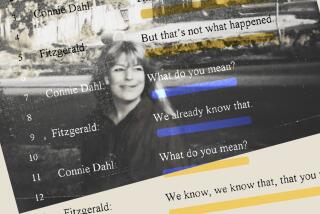Truth and consequences
- Share via
IN his first book, “The Perfect Storm,” Sebastian Junger made clear his attraction to chronicling the unknowable. “I’ve written as complete an account as possible of something that can never be fully known,” he advised us at the start. “It is exactly that unknowable element ... that has made it an interesting book to write.”
If he pulled it off -- and I’d say he did -- it’s because he faced the problem head-on. He didn’t try to reconstruct the events on the doomed fishing vessel, the Andrea Gail; he didn’t pretend to know the inner thoughts of the six fishermen who perished during a monster storm. Rather, Junger consulted those “similarly situated,” those who had survived comparable monster storms or survived the same storm that doomed the Andrea Gail. To that he added a wealth of hard, indisputable information about wind, wave and weather phenomena. And, finally, he took the reader with him, always transparent, always telling us that we can’t know for sure, that “this is as close as one is going to get” to the last moments of the Andrew Gail.
In “A Death in Belmont,” we again find him wrestling with the unknowable, agonizing over how to recognize the truth. This time the unsolvable mystery rises not from imponderable Mother Nature but from something possibly even more perplexing -- the entrenched workings of the criminal justice system.
Junger’s account begins eerily close to his own family, and with a murder -- that of Bessie Goldberg, strangled in her home in Belmont, Mass., a Boston suburb, in March 1963. Although this happened during the height of the infamous Boston Strangler’s killing spree, Goldberg’s murder wasn’t linked to those killings but rather to Roy Smith, a poor black man who’d cleaned her house hours before. As it happened, another man working in Belmont that day -- doing construction work at the home of Junger’s parents -- was Albert DeSalvo, who later confessed to being the Boston Strangler.
Growing up, it all seemed rather clear to Junger. The story he’d heard from his parents was that a nice old lady had been killed and an innocent black man had gone to prison for the crime, although a violent psychopath named Al, working alone at the Junger home (and spooking the author’s mother one day with his “bold male look”), probably committed the murder.
“In our family this story eventually acquired the tidy symbolism of a folk tale,” Junger writes. “Roy Smith was a stand-in for everything that was unjust in the world, and Bessie Goldberg was a stand-in for everything that was decent but utterly defenseless. Albert DeSalvo, of course, was a stand-in for pure random evil.”
Only when Junger began to look deeply into this matter did the simplicity grow far more complex. Was Smith truly innocent, a victim of racism and circumstance? Had DeSalvo really slipped away from the Junger home to kill Goldberg? Was DeSalvo even, in fact, the Boston Strangler? Which to believe -- DeSalvo’s confession or his later recantation? Which to believe, the guilty verdict that confined Smith or the commutation that freed him?
As Junger sets out to resolve such questions in his intensely absorbing and disturbing new book, he becomes ever more entangled in ambiguity. Smith, for example, is no simple innocent but rather a career criminal with a predilection for barroom fighting, petty theft and alcohol; he had been fired from innumerable jobs, had no steady line of work or relationships, no property, no car. DeSalvo’s confessions, meanwhile, sound good only in “highly processed excerpts,” Junger notices. “The raw transcripts tell a different story.... In them, DeSalvo’s descriptions of the murders are clumsy and halting and he often gropes his way through the details only with the help of [a detective] who keeps hinting at the right answers.”
Despite his doubts, Junger tries to cling to a faith in his endeavor as a journalist: “One of the conceits of my profession is that it can discover truth; it can pry open the world in all its complexity and contradiction and find out exactly what happened in a certain place on a certain day.” Yet Junger finally must allow that it only “sometimes can.” Other times, no. “Often the truth simply isn’t knowable -- not, at least, in an absolute way. As I did my research I came to understand that not only was this story far messier than the one I’d grown up with, but that I would never know for sure what had actually happened....”
What Junger confronts here is the unsettlingly inexact nature of our legal system. “At the core of every criminal trial,” he comes to realize, “is the fact that almost anything can be presented in two different ways.... To some degree every trial is an exercise in stretching reality as far as it will go.”
Yet still he persists, inviting the reader to join him in trying to sort out questions -- until he’s forced to throw up his hands again. This time he faces it head on:
“In a criminal trial ... a jury cannot send someone to prison -- or in Smith’s case, to the electric chair -- unless he is guilty ‘beyond a reasonable doubt’ ... [but] trying to define ‘reasonable doubt’ is like trying to define a color.... The central problem with the idea of reasonable doubt -- with the entire premise of man-made justice -- is that it tries to determine an objective truth with subjective tools.... Lacking the ability to ‘see men as God does,’ as one legal scholar puts it, the courts must settle for some lesser version of the truth. That lesser version is known as ‘legal’ guilt.... Ultimately the gap between legal guilt and actual guilt is the gap between human perception and objective truth, and this is a gap that has ruined lives -- and tormented philosophers -- for millennia.”
So Junger, in the end, can reach no simple resolution. Although DeSalvo had been led away in handcuffs, “the question of whether or not he had killed thirteen women ... had still not been answered.” Roy Smith may have died with a governor’s pardon on his nightstand, but “[w]hatever had actually happened at 14 Scott Road in Belmont thirteen years earlier” would remain unclear because “everyone involved was now dead.”
According to recent news accounts, Junger’s book greatly disturbs the daughter of Bessie Goldberg, the woman strangled in Belmont. It is troubling to learn from the victim’s daughter that Junger mistakenly places her in a courtroom as a verdict is read, yet less troubling to learn that she objects to his uncertainty about Roy Smith’s guilt. The recognition of ambiguity, rather than undermining Junger’s book, confers it with a kind of brave distinction. Again this writer has resisted the temptation to impose clarity or shape in a way that might easily satisfy readers hungry for nicely resolved morality tales. “If I was to say something meaningful in this story,” Junger finally decided, “I would have to do it without discovering the truth.” This he has done -- in a manner, of course, that delivers its own kind of truth.
More to Read
Sign up for our Book Club newsletter
Get the latest news, events and more from the Los Angeles Times Book Club, and help us get L.A. reading and talking.
You may occasionally receive promotional content from the Los Angeles Times.







